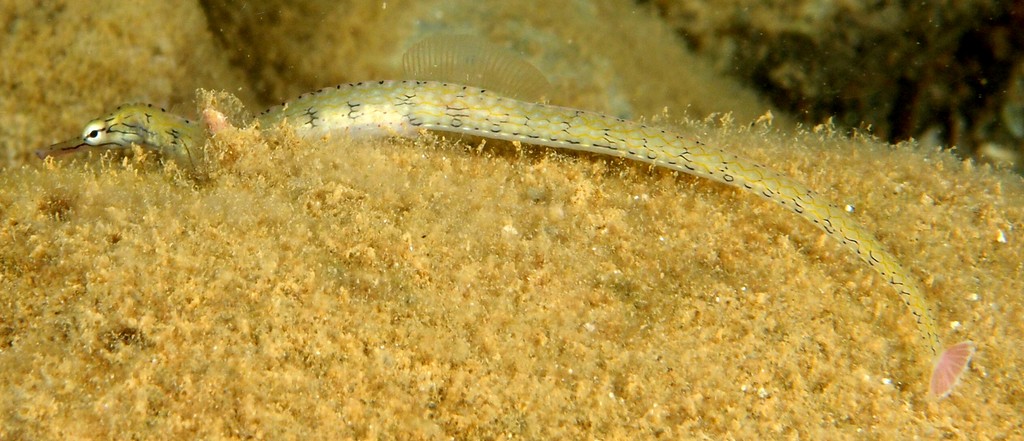CORYTHOICHTHYS CONSPICILLATUS - (JENYNS, 1842)
Actinopterygii (Gigaclass) > Actinopteri (Class) > Teleostei (Subclass) > Syngnathiformes (Order) > Syngnathoidei (Suborder) > Syngnathidae (Family) > Syngnathinae (Subfamily) > Corythoichthys (Genus)
Syngnathe réticulé, Reticulate pipefish, Network pipefish,
Description
Dorsal fin: 26-36; Dorsal fin origin usually before the anterior margin of the first tail ring; Dorsal fin base: 0.7-1.2 in HL; Pectoral fin ray: 13-17; Trunk rings: 15-17; Tail rings: 23-29; Head length: 6.8-10.9 in SL; Short snout: 2.3 in HL; Snout depth: 3.5-6.3 in snout length; Prenuchal and nuchal ridges smooth; Median snout ridge usually with slight dorsal emargination; Eye prominent. Max. length: 18 cm TL (male); 11.3 cm TL (female). Depth range: 0 - 25 m, usually: 0 - 10 m.
Color
Head with prominent lateral stripes, snout with red spots; Trunk with irregularly banded pattern that may be broken up in large blotches and reticulations, yellow streaks or bands in the pale interspaces; Dorsal fin often with rows of translucent spots; males with a blue-black spot on ventral surface of the anal ring. The blue-black blotch around the anus of the male is more intense during courtship.
Etymology
Corythoichthys: from Greek, korys, korythos = helmet + from Greek, ichtys = fish. Referring to “elevated” head rising from large orbits (per Kaup 1856).
conspicillatus: from Latin, conspicillum = lookout post, place for spying out, watching, eyeglass, binoculars. Referring to its “large and full” eyes, “with somewhat of a spectacled appearance”.
Original description: Syngnathus conspicillatus Jenyns, 1842 - Type locality: Tahiti, Society Islands.
Distribution
Western Pacific: Queensland (Australia) and Papua New Guinea east to Austral Islands, south to New Caledonia.
Biology
Lives on seagrass beds or on sand and rubble habitats in sheltered reefs. Sometimes collected for the aquarium trade. Feeds mainly on copepods but also on small isopods and ostracods. Ovoviviparous (gives birth to live young). The eggs are brooded by the males in a pouch under the tail. The pouch protects the dorsal surface and side of the egg mass, leaving the ventral surface exposed. Males begin brooding at 72 mm TL. Males and females form monogamous pairs and tend to remain within their home range. Eggs: Eggs are deposited in 2-17 transverse rows within a gelatinous matrix. Larvae: Planktonic and morphologically similar to the adults; translucent postlarval dorsal and ventral finfolds persist in 39-58 mm SL.
Similar Species
Corythoichthys flavofasciatus (Rüppell, 1838) - Reported from Red Sea, Indian Ocean: East Africa, Seychelles, Comoros, Madagascar, Réunion, Mauritius and Rodrigues (Mascarenes) east to Indonesia. It is the only pipefish in which males have a persistent blue-black blotch on the ventral surface of the anal ring.
Syngnathe réticulé, Reticulate pipefish, Network pipefish,
Description
Dorsal fin: 26-36; Dorsal fin origin usually before the anterior margin of the first tail ring; Dorsal fin base: 0.7-1.2 in HL; Pectoral fin ray: 13-17; Trunk rings: 15-17; Tail rings: 23-29; Head length: 6.8-10.9 in SL; Short snout: 2.3 in HL; Snout depth: 3.5-6.3 in snout length; Prenuchal and nuchal ridges smooth; Median snout ridge usually with slight dorsal emargination; Eye prominent. Max. length: 18 cm TL (male); 11.3 cm TL (female). Depth range: 0 - 25 m, usually: 0 - 10 m.
Color
Head with prominent lateral stripes, snout with red spots; Trunk with irregularly banded pattern that may be broken up in large blotches and reticulations, yellow streaks or bands in the pale interspaces; Dorsal fin often with rows of translucent spots; males with a blue-black spot on ventral surface of the anal ring. The blue-black blotch around the anus of the male is more intense during courtship.
Etymology
Corythoichthys: from Greek, korys, korythos = helmet + from Greek, ichtys = fish. Referring to “elevated” head rising from large orbits (per Kaup 1856).
conspicillatus: from Latin, conspicillum = lookout post, place for spying out, watching, eyeglass, binoculars. Referring to its “large and full” eyes, “with somewhat of a spectacled appearance”.
Original description: Syngnathus conspicillatus Jenyns, 1842 - Type locality: Tahiti, Society Islands.
Distribution
Western Pacific: Queensland (Australia) and Papua New Guinea east to Austral Islands, south to New Caledonia.
Biology
Lives on seagrass beds or on sand and rubble habitats in sheltered reefs. Sometimes collected for the aquarium trade. Feeds mainly on copepods but also on small isopods and ostracods. Ovoviviparous (gives birth to live young). The eggs are brooded by the males in a pouch under the tail. The pouch protects the dorsal surface and side of the egg mass, leaving the ventral surface exposed. Males begin brooding at 72 mm TL. Males and females form monogamous pairs and tend to remain within their home range. Eggs: Eggs are deposited in 2-17 transverse rows within a gelatinous matrix. Larvae: Planktonic and morphologically similar to the adults; translucent postlarval dorsal and ventral finfolds persist in 39-58 mm SL.
Similar Species
Corythoichthys flavofasciatus (Rüppell, 1838) - Reported from Red Sea, Indian Ocean: East Africa, Seychelles, Comoros, Madagascar, Réunion, Mauritius and Rodrigues (Mascarenes) east to Indonesia. It is the only pipefish in which males have a persistent blue-black blotch on the ventral surface of the anal ring.
